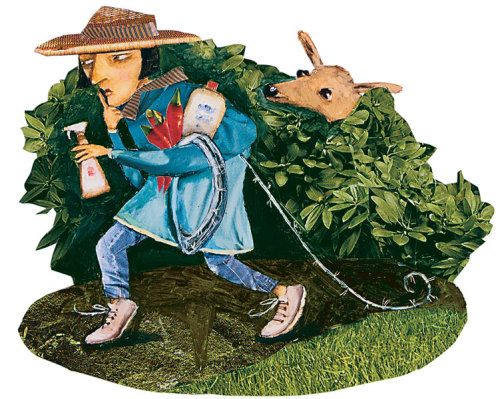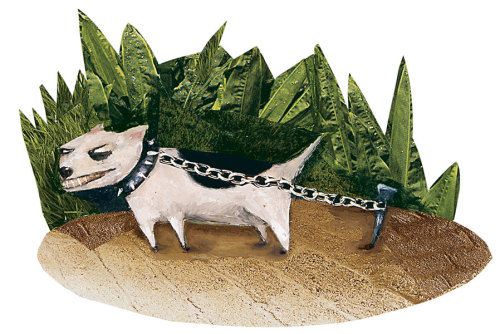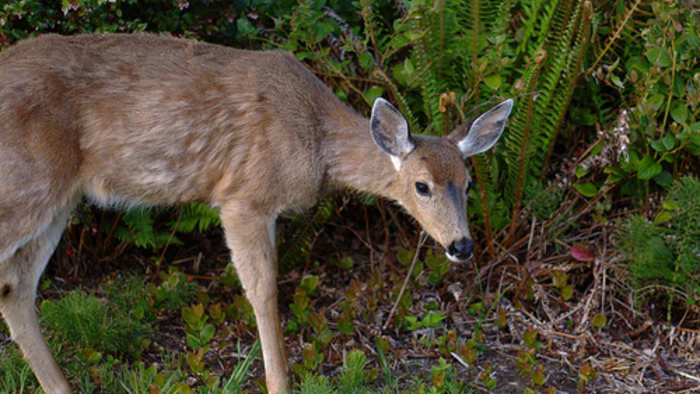
It is a clear moonlit night in the orchard. Ripening apples droop from branches and among the fruit dangle fragrant bars of soap, old panty hose stuffed with human hair, and sponges soaked in animal urine. What strange ritual is this? A prelude to utterance of ancient incantations? No, no one is in sight. Then, quiet as the night, a deer glides past the sponges, the soap, and the dancing panty hose and takes a large bite out of a moonlit apple. The crunch echoes through the night. Rituals and hope have failed to protect the prize.
In many areas, these eager herbivores no longer wait for darkness. In a back yard in El Cerrito, California, deer watch from the bushes as the gardener works. A bold buck must be shooed away before the lawn can be mowed.
And comrades sleep close by.
Deer have not always been pests. Native Americans regarded deer as magical creatures. Early pioneers relied on them as an essential food source. Deerskins were used by settlers as a form of currency, leading to the slang term “bucks.” Now, perceptions of these creatures are colored by a not-in-my-back-yard attitude. When deer dine on a prized yew, or trash the apple tree, the vegetable garden, and the rose bush, gardeners don’t appreciate the worth of deer.
Deer have become suburban dwellers not by choice, but by necessity. Houses have replaced habitat, leaving deer to forage in a new suburban environment. Grasses and shrubs take the place of mature forest, providing deer with preferred food that can cause populations to surge. Natural predators that once checked deer populations, such as coyote, have been hunted, trapped, and poisoned.

A deer-proof vegetable is hard to find
A kitchen garden is seen by the neighborhood deer as a salad bar, complete with condiments. Ornamentals are somewhat easier to protect than edibles, as deer-resistant species are available. Though a deer-proof vegetable is hard to find, some plants are preferred over others. Deer do not like onions and garlic, and if they must choose between an apple and broccoli, they will go for the apple. They especially like corn, beet greens, and peas, but no garden vegetable is safe.
The situation, however, is not hopeless. There are answers to the problem, with varying degrees of effectiveness. For gardens with low foraging pressure, repellents can help. For areas with high foraging pressure, you’re going to need extreme measures. A dog can be effective, if not afflicted with narcolepsy. If you really want to protect your garden, install a fence. Fences range from an inexpensive, one-strand electric fence to an 8-foot high exclusion fence to wrought iron masterpieces costing thousands.
Man’s best friend is a deer’s worst enemy
A dog can be a deterrent, as long as the deer perceive the dog as a threat. Invading deer are initially repelled by a barking, tethered dog. But once they learn the tied-up dog can’t reach them, they begin to feast. You can purchase battery-charged dog collars that leave dogs free to roam, but give them an electric shock when they stray outside a given area. These virtual fences are expensive and not always reliable, and if the range is often challenged by the canine, the batteries drain quickly. The best dog for garden protection is a well-trained herding dog, such as a collie or German shepherd.
Dung of lion, extract of chile
Repellents slow snacking deer. There are two kinds: contact and area repellents. Contact repellents are sprayed on the plant to be protected. Deer take one bite of the awful-tasting stuff and then avoid it. Most contact repellents registered for deer control, however, cannot be used on food plants. One exception is an inexpensive, non-toxic repellent called Not Tonight Deer™, a mixture containing 6% hot pepper and 94% dried egg solids. Another repellent registered for food crops is called Hinder®, which is an ammonium soap. Depending on foraging pressure, both can give short-term protection to small areas. A homemade spray can be made by dissolving 2 tablespoons of ground hot pepper (which also seems to repel cabbage butterflies) in a gallon of water containing 6 drops of liquid detergent. Check plants for damage and altered taste if you use this repellent. Treated vegetables should be washed
before eating.
Area repellents include the usual suspects: bars of soap or bags of hair hung every 3 ft. on stakes along the garden row. Deer are neophobic, meaning any kind of bizarre change will repel them—until they learn there’s nothing to worry about. When many deer are trying to feast on attractive food, area repellents will be effective for three days, at most. Dung of lion, dog, and cat are probably more repellent to gardeners than to deer.
Good fences make gardeners happy
For moderate to high foraging pressure, the best solution is often a simple, one-strand electric fence. Sometimes called the Minnesota fence, a design of this type works through behavior modification. A wire is run 4 feet off the ground, with posts or trees every 12 feet. Electricity is supplied by a 6- or 12-volt battery-operated transformer that puts out high voltage at a low current.
To attract deer to the fence, wrap adhesive tape around the wire in 3-in. sections at 2-ft. to 3-ft. intervals. Then coat the 3-in. section with peanut butter. Cover the bait with aluminum foil flaps, which make the fence highly visible. When a deer approaches the bait, it will touch the foil with its tongue. The resulting buzz of voltage will not hurt the deer, but it will teach it to stay away.
This fence, however, may not be the best choice for families with young children. Contact with a live fence will cause a minor buzz of electricity but no damage. One solution is to turn the fence off during the day, when deer are less likely to forage.

Exclusion fences
If herds of deer are queuing up at your salad bar, a strong exclusion fence is needed. Deer can jump up to 8 ft.; for the fence to be 100% effective it must be this height. An effective 8-ft.-high deer fence can be constructed by stacking two 4-ft. widths of strong wire fencing. Use 12-ft.-high posts, and fit the bottom of the fence tightly against the ground, or deer will slink under it.
A webbed polypropylene fence is inexpensive and can be strung between posts or trees. It, too, should be 8 ft. high to keep the deer from leaping over it. A ravenous deer might, however, break through.
Forget chicken wire as fencing, as it is too weak. Welded wire fencing is affordable and effective for small areas. If you want your garden to have a sense of openness, paint the fence black so it’s less obtrusive. If there is no concern about a walled-in feeling, vines and other ornamentals can be trained to cover the fence. Choose English ivy, jasmine, or some other deer-resistant plant. Keep your eyes open and your wits about you, because, after all, it’s a battle out there. And tell those pests, “Not tonight, deer.”
Range of the deer problem
When Columbus arrived on the continent, there were 23 to 34 million native white-tailed deer. By 1900, hunting had reduced numbers to 1 million. With restocking and conservation in the national parks, the white-tailed population today has climbed to 12 million, while the total deer population in the United States—including mule deer in the West—is about 20 million.
Deer are not spread uniformly across the country, and thus deer problems vary with environment and ecology. Depending on the area, deer can be either plentiful pests or a protected species dangerously near extinction. In 12 midwestern agricultural states, pest populations are large, and up to 700,000 each year are killed by hunters. In the Northeast, orchards provide deer with favored food but rural and suburban gardens are also attacked. Deer populations are relatively small, and hunting is moderate in these areas. In California, deer have become familiar suburban pests.
| Learn more at FineGardening.com: • Deer-Proof Electric Fence • Deer: Getting to Know the Enemy |
The largest deer population in the U.S. may be in the northern forest of Michigan, Minnesota, and Wisconsin. Deer food there is mostly browse—tender shoots, twigs, and leaves—which encourages population numbers. Every year in this area 300,000 to 500,000 deer are killed by intensive hunting. In the Florida Keys, on the other hand, deer are endangered, and cannot legally be hunted.
by William Quarles
August 1998
from issue #16
Drawings: Krysten Brooker
Fine Gardening Recommended Products

A.M. Leonard Deluxe Soil Knife & Leather Sheath Combo
Fine Gardening receives a commission for items purchased through links on this site, including Amazon Associates and other affiliate advertising programs.

ARS Telescoping Long Reach Pruner
Fine Gardening receives a commission for items purchased through links on this site, including Amazon Associates and other affiliate advertising programs.

Attracting Beneficial Bugs to Your Garden, Revised and Updated Second Edition: A Natural Approach to Pest Control
Fine Gardening receives a commission for items purchased through links on this site, including Amazon Associates and other affiliate advertising programs.




















Comments
Log in or create an account to post a comment.
Sign up Log in